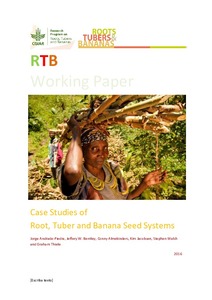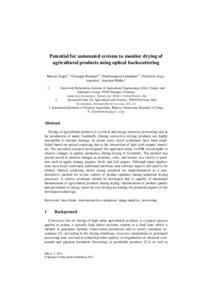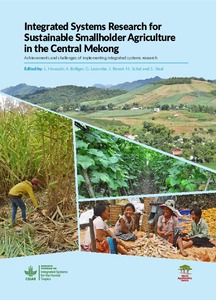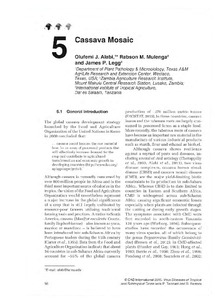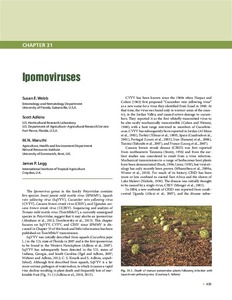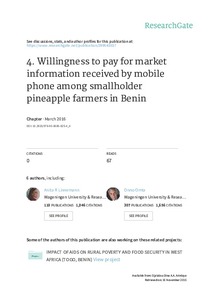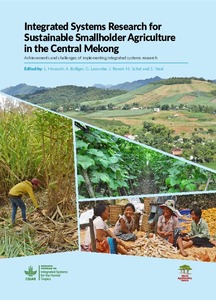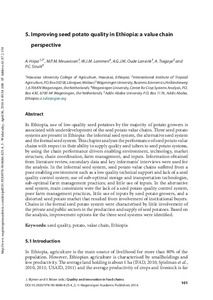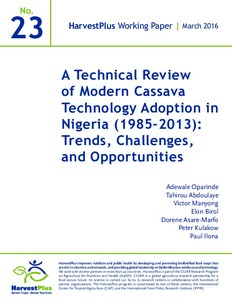Welcome to the International Institute of Tropical Agriculture Research Repository
Books and Book Chapters: Recent submissions
Now showing items 961-977 of 977
-
Releasing disease-resistant varieties of cassava in Africa
(2016)UPoCA (Unleashing the Power of Cassava in Africa) was part of the long-term, international effort to manage the food price crisis (which started in 2008). The project shared 59 new cassava varieties with at least 11,540 smallholders across seven African countries. The project worked with sub-contracted seed farms, which kept the cassava roots and some of the stems, turning over most of the stems to the project to deliver to other farmers, especially those linked to cassava-based industries. The ... -
Influence of osmotic pretreatment and drying air properties on bioactive compounds of fruits
(Taylor & Francis, 2016) -
Potential for automated systems to monitor drying of agricultural products using optical scattering
(Springer International Publishing, 2016-08-03)Drying of agricultural products is a critical and energy-intensive processing step in the production of many foodstuffs. During convective drying, products are highly susceptible to thermal damage. In recent years, novel techniques have been established based on optical scattering due to the interaction of light with organic materials. The presented research investigated this approach using vis/NIR wavelengths to observe changes of quality parameters during drying of foodstuffs. The method was proven ... -
Approaches to reinforce crop productivity under rain-fed conditions in sub-humid environments in Sub-Saharan Africa
(Springer International Publishing, 2015-09-03)Smallholder farming in much of Sub-Saharan Africa is rain-fed and thus exposed to rainfall variability. Among the climate variables, rainfall is projected to decline and have an overriding effect on crop productivity. With little opportunity for supplementary irrigation for the majority of farmers, a plausible strategy to maintain crop production under water-limited conditions includes balanced nutrient management for enhancing efficiency of use of limited soil water. Co-application of judicious ... -
Integrated systems research for sustainable smallholder agriculture in the uplands of mainland Southeast Asia: Achievements and lessons learned
(World Agroforestry Centre, 2016-11-15) -
A review of efforts to integrate nutrition in systems research
(World Agroforestry Centre, 2016-11-15) -
Cassava brown streak
(CABI Wallingford, 2015)Cassava 'brown streak' disease (CBSD) is an economically important constraint in important cassava-growing areas of East, Central and Southern Africa. In addition to causing a dry necrotic rot in the tuberous roots of infected plants, which can render them inedible, CBSD depresses yields through reducing plant growth. This pandemic of CBSD is driven by the high abundance of the whitefly vector, Bemisia tabaci, coupled with uncontrolled movements of infected cuttings used as planting material. This ... -
Cassava mosaic
(2015)Although cassava shows resilience against a myriad of pests and diseases, including several of viral aetiology, two virus disease complexes, cassava brown streak disease and cassava mosaic disease (CMD), are the major yield-limiting biotic constraints to its production in sub-Sahara Africa. Subsequent studies have recorded the occurrence of many virus species, all of which belong to the genus Begomovirus (family Geminiviridae), in CMD-affected plants. This chapter presents the symptopms, causative ... -
perspectives on the application of next generation sequencing to the improvement of Africa's staple food crops
(2016-01-14)The persistent challenge of insufficient food, unbalanced nutrition, and deteriorating natural resources in the most vulnerable nations, characterized by fast population growth, calls for utilization of innovative technologies to curb constraints of crop production. Enhancing genetic gain by using a multipronged approach that combines conventional and genomic technologies for the development of stress-tolerant varieties with high yield and nutritional quality is necessary. The advent of next-generation ... -
Ipomoviruses
(The American Phytopathological Society, 2016)The Ipomovirus genus in the family Potyviridae contains five species: Sweet potato mild mottle virus (SPMMV), Squash vein yellowing virus (SqVYV), Cucumber vein yellowing virus (CVYV), Cassava brown streak virus (CBSV), and Ugandan cassava brown streak virus (UCBSV). Sequencing and analysis of Tomato mild mottle virus (TomMMoV), a currently unassigned species in Potyviridae,suggest that it may also be an ipomovirus. This chapter focuses on Squash vein yellowing virus (SqVYV), Cucumber vein yellowing ... -
Willingness to pay for market information received by mobile phone among smallholder pineapple farmers in Benin
(Wageningen Academic Publishers, 2016)Access to up-to-date information on market prices and quality requirements remains a key issue for smallholder farmers’ access to high income markets. The aim of this chapter is to explore the problem of information asymmetry between farmers and buyers in the pineapple supply chain in Benin, and to assess strategies using mobile phones to overcome this problem. Data was collected from an exploratory case study in Ghana and a survey with 285 farmers in Benin. Results show that farmers face market ... -
Integrated systems research for sustainable smallholder agriculture in the Central Mekong: Achievements and challenges of implementing integrated systems research
(World Agroforestry Centre, 2016-11-15) -
Methods for environment: productivity trade-off analysis in agricultural systems
(Springer International Publishing, 2016-08-24)Trade-off analysis has become an increasingly important approach for evaluating system level outcomes of agricultural production and for prioritising and targeting management interventions in multi-functional agricultural landscapes. We review the strengths and weakness of different techniques available for performing trade-off analysis. These techniques, including mathematical programming and participatory approaches, have developed substantially in recent years aided by mathematical advancement, ... -
Improving seed potato quality in Ethiopia: a value chain perspective
(Wageningen Academic Publishers, 2016)In Ethiopia, use of low-quality seed potatoes by the majority of potato growers is associated with underdevelopment of the seed potato value chains. Three seed potato systems are present in Ethiopia: the informal seed system, the alternative seed system and the formal seed system. This chapter analyses the performance of seed potato value chains with respect to their ability to supply quality seed tubers to seed potato systems, by using the chain performance drivers enabling environment, technology, ... -
A technical review of modern cassava technology adoption in Nigeria (1985-2013): trends, challenges, and opportunities: HarvestPlus working paper, No. 23
(International Food Policy Research Institute, 2016-03)In recent times, results of various adoption studies have been mixed, raising questions regarding why some improved farm technologies are still not widely adopted several years after their first introduction. Many improved cassava varieties have been introduced to millions of farm households across Africa south of the Sahara. Using an extensive review of cassava-adoption literature focused on Nigeria, this paper discusses the uptake of improved cassava varieties. Generic measurement and methodological ...

